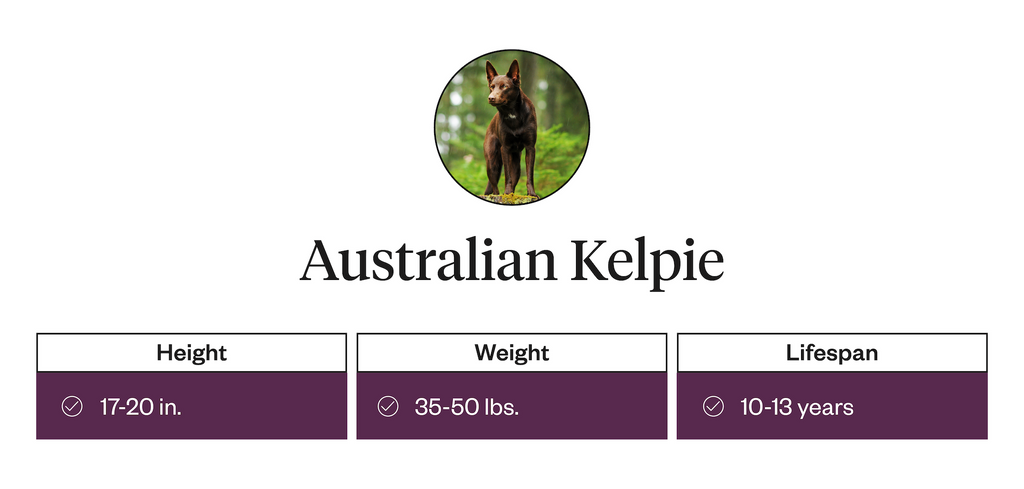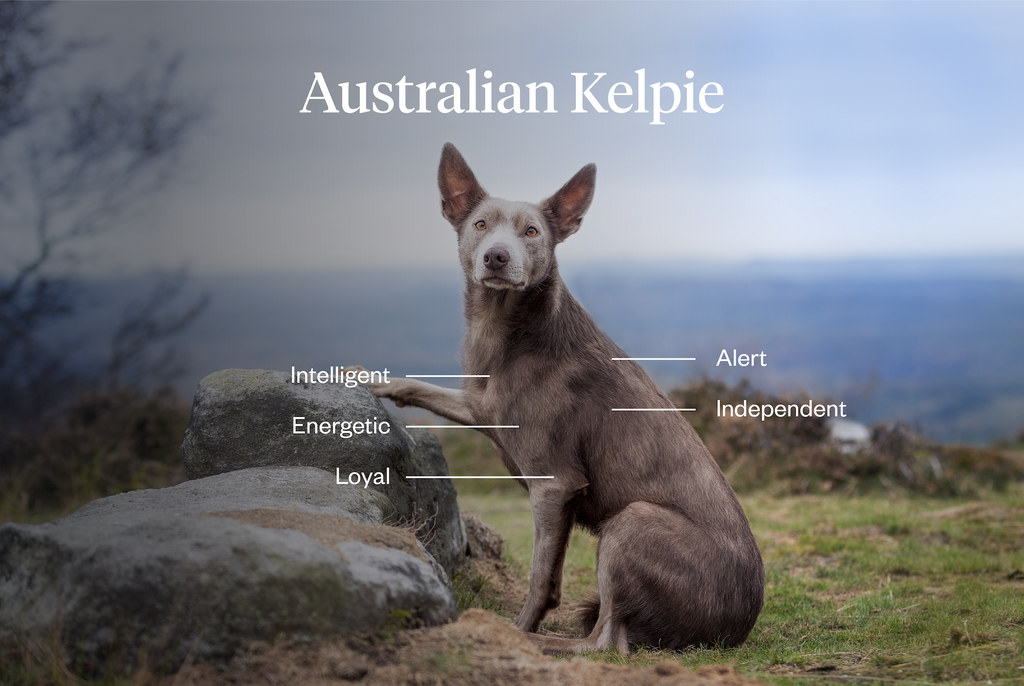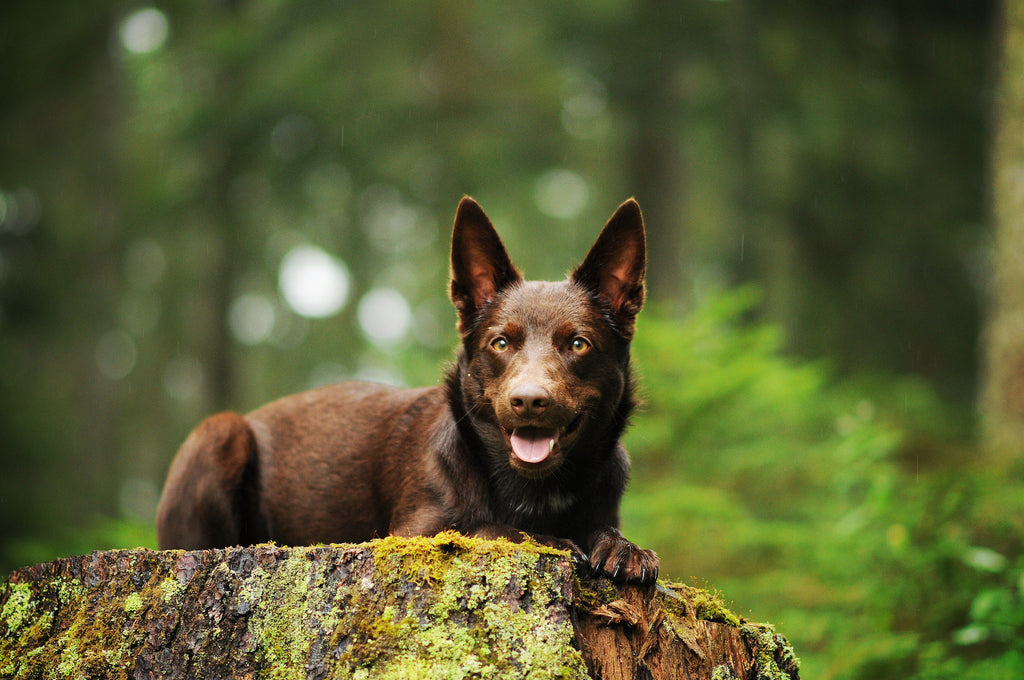9 Min Read
Australian Kelpie: Pet Profile
Key takeaway
Australian Kelpies are a sheep-herding dog known for loyalty, hard work, and energy. Kelpies are great work dogs that are generally friendly, though they are at risk for certain health conditions. As long as you can keep your kelpie active and enriched, they’re great dogs whether you’re on a farm or looking for a family pet.

Why pet owners are switching to online vet care with Dutch
-
Prescriptions delivered free to you
-
Fast access to Licensed Vets over video
-
Unlimited video visits and follow-ups
The Australian Kelpie — also called the Kelpie — is a type of sheepdog from Australia. Kelpies are active dogs that are smart and loyal, which makes them a popular choice for farms.
If you’re looking for a hard-working dog that responds well to obedience training, Australian Kelpies are an excellent choice. Kelpies can quickly learn new tricks because they’re so smart, and they do a good job of listening and behaving when trained well.
So, is an Australian Kelpie puppy the right choice for you and your family? Here’s what you need to know about this Australian breed so you can calculate the costs of pet ownership.
- History & Origin Of Australian Kelpies
- Physical Attributes Of The Australian Kelpie
- Behavioral Characteristics Of The Australian Kelpie
- Australian Kelpie Health Risks
- Caring For Kelpies
- Australian Kelpie: FAQs
- Final Notes
History & Origin Of Australian Kelpies
The Australian Kelpie has a history that begins with early landholders in Australia. This breed came from a combination of working collies, beginning with a dog named Kelpie. J.D. Gleeson trained Kelpie for sheep work at Ballarook station. When transferring to another station in New South Wales, Gleeson met Mark Tully, who gave him an all-black dog named Moss. Moss and Kelpie mated, leading to the beginning of the Kelpie dog that we know today.
These puppies were known as “Kelpie’s pups” because of their mother. Over time, this terminology evolved and Kelpie became the name of the breed. Since then, Kelpies have become a popular breed for working dogs and trial dogs. In fact, the Kelpie breed became popular after a Kelpie won the Forbes Sheepdog Trial.
Physical Attributes Of The Australian Kelpie

At the withers, the Australian Kelpie dog is about 46 to 51 cm for a male and 43 to 48 cm for a female. Males weigh about 15 to 20 kg while females typically weigh between 11 and 16 kg. The Kelpie is a medium-sized dog, which makes them easier to house and care for than larger dogs.1
As far as the coat goes, there are many varieties of kelpies. Kelpies can have a black coat with or without tan markings. Some kelpies have a blue (gray) coat that may or may not have tan markings. Other colors include red — which can come with or without tan markings — and tan. Some kelpies also have white markings, so appearances can vary quite a bit.1
The Australian Kelpie has a solid, muscular appearance despite not being the largest dog breed. These muscles are built by hard work, giving the Kelpie a clean, defined appearance. Because of the size and build of the Australian Kelpie, this breed is often used for agility training as well as sheep herding.1
Kelpies have a short, flat coat, which also makes them easier to care for. Choosing a dog with a shorter coat typically means less shedding, so your home won’t be covered in dog hair.1
Behavioral Characteristics Of The Australian Kelpie

A lot of the behavioral traits you’ll find in Australian Kelpies are a result of the breed’s sheepdog origins. Because kelpies are working dogs, they’re often alert and active with an almost endless amount of energy. This can also make kelpies a great choice for agility training and other activities that require a lot of energy.
Kelpies are often devoted to work, with a natural tendency to herd like other types of sheep dogs. The Australian Kelpie temperament is generally characterized by hard work and obedience, which is why kelpies are usually relatively easy dogs to train.
If you’re looking for a dog that’s loyal, alert, intelligent, energetic, and friendly, Australian Kelpies may be the right breed for you.
Australian Kelpie Health Risks

As a pet parent, understanding the health risks associated with your dog’s breed can help you take better care of them. Understanding breed health risks is one of the dog essentials. Kelpies have a few common health problems, including hip dysplasia, progressive retinal atrophy, collie eye anomaly, and degenerative myelopathy.2
Hip dysplasia is a deformation of the hip that can cause pain and weakness in the hind legs. Hip dysplasia is a genetic disease that’s more common in certain dog breeds, including various types of sheep dogs and larger breeds. In addition to genetics, hip dysplasia is also affected by diet, environment, exercise, muscle mass, and hormones. You can talk to your vet to learn more about preventing hip dysplasia.
Progressive retinal atrophy (PRA) is an eye disease that eventually leads to blindness. This disease causes cells in the retina to degenerate as a result of genetics. In the early stages, PRA often affects a dog’s ability to see at night. Several types of Australian cattle dogs — including the kelpie — are at higher risk for PRA.3
Collie eye anomaly (CEA), or choroidal hypoplasia (CH), is an eye disease that affects the choroid layer of the eye. The severity of CEA can vary quite a bit, with severe cases leading to retinal detachment, malformation of the eye or optic nerve, and blindness. This condition is more prevalent in certain breeds, including the Australian Kelpie.4
Degenerative myelopathy is caused by a genetic mutation that’s found in certain breeds, especially kelpies. Over time, this condition can lead to a loss of coordination and eventually affect a dog’s ability to walk.
When raising a kelpie, you should also consider general conditions that affect various dog breeds. For example, gum disease in dogs is fairly common without good oral health. Your vet can help you stay on top of all the routine care that helps keep your kelpie healthy.
Caring For Kelpies
Kelpies are great dogs if you take good care of them, but they need to get plenty of exercise and eat a healthy diet to maintain a healthy weight. Coat care is important, though kelpies’ coats are fairly easy to care for since they’re short and straight. Here’s what you need to know about taking care of kelpies.
Diet & Nutrition
Every dog needs to eat a healthy diet that includes a mixture of meat and plant-based food. Kelpies are medium-sized dogs that should be lean and muscular, so you don’t want to overfeed your kelpie.
Active adult dogs that weigh 30 lb should eat about 922 calories per day, while active adult dogs that weigh 50 lb should eat about 1,353 calories daily. This diet should include a healthy mix of nutrients, including proteins, amino acids, fats, and fatty acids.5
Choosing the right food for your kelpie is important. You can talk to your vet to get help finding AAFCO-approved commercial food. Getting help from your vet is a great way to make sure your kelpie is eating a healthy diet that contains all the essential nutrients.
Grooming
Kelpies have a short, straight coat, which makes them relatively easy to care for. Your kelpie needs all the grooming that any short-haired dog needs, including brushing, eye care, ear care, dental care, and paw care.
Brushing helps keep your kelpie clean and maintains a healthy coat. Short-haired dogs like kelpies should be brushed at least once a week. When you brush your dog’s coat, you can also inspect and clean their eyes and paws.
Ear care is essential when it comes to preventing ear infections, and it’s a simple monthly routine. Kelpies have pointed ears that don’t typically hang down, which means they need to be cleaned about once a month. Your vet can recommend an ear cleanser.
Dental care keeps your dog’s teeth and gums healthy, preventing gum disease and other dental problems. You can give your dog chewable dental treats, but you should brush your dog’s teeth at least once a day. Ideally, you should brush your dog’s teeth twice a day like you do your own teeth.
Exercise & Enrichment
Kelpies are active dogs, which means they’re happy when they’re getting lots of exercise. Kelpies need to exercise regularly, whether they’re running around in your yard or going for a walk or jog. Exercising helps keep your kelpie enriched while aiding with weight management, which is key for any dog breed.
Obedience training can also be beneficial for kelpies.
Preventative Care & Veterinary Check-Ups
Taking care of your dog means staying on top of check-ups and preventative care.
Kelpies are prone to fleas and ticks just like other dog breeds. You can use NexGard chewables or Credelio to prevent fleas and ticks, following your vet’s instructions to keep up with preventative care. Preventing fleas and ticks keeps your kelpie’s coat healthy and prevents diseases.
As a general rule, you should take your dog to the vet about once a year for a check-up. Regular check-ups help you keep your pets healthy and catch diseases and medical conditions early. Your vet can also help you monitor your dog’s weight, dental health, and more.

Australian Kelpie: FAQs
Do Australian Kelpies bark a lot?
Australian Kelpies have a tendency to bark at times, so you’re going to have some noise with a kelpie around. Kelpies may bark as a result of a lack of stimulation, which is why it’s important to keep your kelpie busy and get them plenty of exercise.
Are Kelpies good with children?
Kelpies are generally considered to be good with children, but you may want to supervise your kelpie around younger children. Kelpies love to herd, and it’s not uncommon to see your kelpie trying to round up your children.
Are Australian Kelpies half dingo?
While it’s often said that kelpies were once bred with dingos, there’s no genetic evidence to suggest that. Kelpies are a result of combining a few different dog breeds, but dingos and other wild dogs aren’t part of the equation.6
Final Notes
If you’re looking for a dog that’s loyal, energetic, and friendly, kelpies are an excellent breed. Australian Kelpies are hard workers, and they’re great dogs as long as you keep them enriched and active. Kelpie dog attributes also make them a good breed for families.
Whether you’ve got a puppy or an adult dog, taking care of pets can be a lot of work. With telemedicine for pets, you can get the help you need from the comfort of your home. Dutch allows you to video chat with vets online and get prescriptions delivered to your doorstep. Try Dutch and find out how we can help you keep your pets healthy and happy.
Share
References
-
FCI Breed Standard for Australian Kelpies (FCI Standard No. 293), PDF.
-
Cornell University's College of Veterinary Medicine. "Progressive Retinal Atrophy," https://www.vet.cornell.edu/departments-centers-and-institutes/riney-canine-health-center/canine-health-information/progressive-retinal-atrophy.
-
Paw Print Genetics. "Progressive Retinal Atrophy (PRA-PRCD) in Dogs," https://www.pawprintgenetics.com/products/tests/details/92/?breed=210.
-
Paw Print Genetics. "Collie Eye Anomaly (CEA) in Dogs," https://www.pawprintgenetics.com/products/tests/details/87/?breed=210.
-
National Academies. "Your Dog's Nutritional Needs." https://nap.nationalacademies.org/resource/10668/dog_nutrition_final_fix.pdf
-
University of Sydney. "Strewth, Turns Out Your Kelpie Is Not a Dingo," https://www.sydney.edu.au/news-opinion/news/2019/05/27/strewth--turns-out-your-kelpie-is-not-a-dingo.html.



